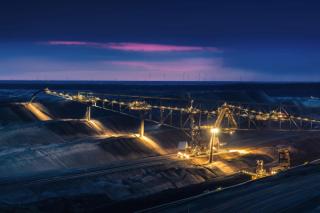
Cultural heritage: Indigenous and cultural heritage values driving sustainable development
by Flavia Kiperman
View post

It is widely recognised that the planet is experiencing long-term shifts in weather patterns and global temperatures, due to human activities. This has been largely driven by the burning of fossil fuels for energy and transportation, which in turn releases significant amounts of CO2 into the atmosphere. The accumulation of these greenhouse gases then traps heat from the sun and causes the Earth’s temperature to rise.
Wide-scale deforestation, industrial processes and agricultural practices also contribute to these emissions, and while the overall approach to mitigating and adapting to climate change is centred on decarbonisation, Nature-based Solutions (NbS) can also play a crucial role. The current decline of natural capital poses a substantial risk to business operations and the global economy. To mitigate this, it’s imperative for businesses to understand the importance behind implementing NbS.
To foster this understanding, we will be sharing a series of articles over the coming months. These articles will illustrate how implementing these solutions can address societal challenges and provide additional benefits compared to hard engineered solutions, whilst contributing to a Nature positive world.
This introductory article delves into the “what” behind NbS, the differing categories and most frequently adopted options and, how our team are supporting businesses in achieving their sustainability goals through development and implementation.
They are actions to protect, sustainably manage and restore natural and modified ecosystems that address societal challenges effectively and adaptively, simultaneously benefiting people and nature.
These solutions are based on the principle that healthy ecosystems can provide a range of benefits, including carbon sequestration, climate regulation, water management, biodiversity conservation and human wellbeing. These are also sometimes referred to as Natural Climate Solutions, particularly when specifically aimed at climate mitigation, while they are often aimed at wider benefits including alternatives to engineered solutions and wider social and biodiversity benefits. We go into more detail about each of these benefits in this article.
The International Union for Conservation of Nature (IUCN) define NbS as:
“Nature-based Solutions address societal challenges through actions to protect, sustainably manage, and restore natural and modified ecosystems, benefiting people and nature at the same time.
They target major challenges like climate change, disaster risk reduction, food and water security, biodiversity loss and human health, and are critical to sustainable development. “
The IUCN have compiled a Global Standard which provides a user-friendly framework for the verification, design and scaling up of NbS (1).
While there are some broad categories, the opportunities can be very site and challenge specific, making the full list of potential actions and benefits almost limitless. We have summarised some of the most frequently adopted options in Table 1 below.
Broadly, NbS can be split into the following categories (2):

With expertise across more than 45 disciplines, our team offers comprehensive aquatic environmental, ecology, and biodiversity services globally. Our industry-leading specialists can support your organisation with governance and strategy advice, as well as operational project support to integrate NbS at every stage of the value chain and project lifecycle.
Some examples of our experience include:
Connecticut National Estuarine Research Reserve, USA
The Connecticut National Estuarine Research Reserve faced significant challenges due to rising sea levels and increased frequency of intense precipitation events, threatening critical infrastructure and community safety. SLR provided climate resilience planning and design services to address these challenges. The team conducted detailed risk assessments to identify vulnerable areas and developed adaptive strategies, including the implementation of green infrastructure solutions such as permeable pavements and rain gardens. Community engagement initiatives were also conducted to raise awareness and preparedness among residents.
Key Outcomes
Enhanced infrastructure resilience through the implementation of green infrastructure solutions such as permeable pavements and rain gardens. Improved community preparedness by conducting awareness and preparedness initiatives. Increased environmental stewardship by promoting sustainable design practices.
Brattleboro Housing Partnership, USA
Brattleboro Housing Partnership faced challenges in providing safe and affordable housing due to the increasing risks of extreme weather events such as flooding and severe storms. SLR's integrated approach focused on climate adaptation planning for housing infrastructure. The team worked closely with local stakeholders to develop resilient housing solutions that incorporated green building practices and sustainable materials. Specific measures included elevating structures above flood levels, improving drainage systems, and enhancing energy efficiency to reduce carbon footprints.
Key Outcomes
Improved housing resilience by elevating structures above flood levels and enhancing drainage systems. Reduced flood risk through strategic infrastructure adaptations. Enhanced community safety by providing safe and affordable housing for vulnerable populations.
Australian Rail Track Corporation, Australia
The Ardglen Railway Widening Project aimed to improve transportation efficiency and capacity by widening the existing railway. However, this posed significant ecological challenges, including potential impacts on local flora and fauna. SLR conducted detailed ecological surveys to identify and mitigate these impacts. The assessment included habitat evaluations, species impact studies, and recommendations for conservation measures. Solutions included creating wildlife corridors, implementing habitat restoration projects, and monitoring programs to ensure the long-term health of local ecosystems.
Key Outcomes
Improved transportation infrastructure by widening the railway to enhance efficiency and capacity. Minimized ecological impact through habitat evaluations and species impact studies. Enhanced conservation efforts by implementing wildlife corridors and habitat restoration projects.
Alvance British Aluminium, UK
Alvance British Aluminium faced challenges in reducing greenhouse gas emissions and protecting biodiversity in their operations. SLR supported the company with a comprehensive GHG emissions reduction and biodiversity impact assessment. The team developed a GHG emissions reduction plan, conducted a baseline biodiversity risk assessment, and recommended habitat enhancements to maximize biodiversity on site. Solutions included implementing energy efficiency measures, transitioning to renewable energy sources, and habitat restoration projects to improve ecosystem health.
Key Outcomes
Reduced greenhouse gas emissions by implementing energy efficiency measures and transitioning to renewable energy sources. Improved biodiversity through habitat restoration projects and biodiversity enhancements. Enhanced habitat quality by strategically maximizing biodiversity and contributing to overall ecosystem health.
NbS are not without challenges and while they clearly have a significant role to play, there are concerns about the way in which they are implemented. Firstly, how these could be used for offsetting purposes and, in doing so, could delay the broader decarbonisation process; and also, the risks their impact poses on existing biodiversity, coupled with local communities and indigenous peoples. It is also critical that any solutions are properly managed, with a long-term commitment to quality and integrity.
Implementing these solutions opens significant opportunity to accelerate sustainable approaches to addressing climate change and the biodiversity crisis. Delivering on this ambition will require technical specialists (including ecologists, hydrologists, hydrogeologists, engineers, soil scientists, economists, social scientists, and climate scientists), collaborating to plan, design and implement innovative schemes that work and integrate with primary project outcomes.
If you would like help in understanding how NbS can play a role for you, please get in touch with one of our technical specialists today. To learn more about Nature, Natural Capital & Biodiversity, visit Nature, Natural Capital & Biodiversity.
Our next article in the series will dive deeper into some of the key challenges and opportunities within the aquatic industry to support infrastructure developments through an NbS lens.
Read moreSources
(1) https://portals.iucn.org/library/sites/library/files/documents/2020-020-En.pdf
(2) https://wedocs.unep.org/bitstream/handle/20.500.11822/40783/nature_based_solutions.pdf?sequence=3&isAllowed=y

by Flavia Kiperman

by Jasper Schrijvers , Matthew Hoare

by Clodagh Connolly, Nicola Inge, Andres Schottlaender